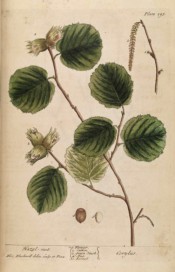Corylus avellana L.
Fully hardy upright or tree-like shrub with broadly heart-shaped leaves and pendant catkins in winter and spring, followed by the edible nuts. To 5m. An important economic crop. The Filbert differs from the common Hazel-nut in having nuts in ones, twos or threes completely enclosed in a longer, lobed husk. [RHSE, Hortus, Hilliers’].
Horticultural & Botanical History
Ancient garden plant. ‘The Hasel. Corylus. This shrub seldome grows to any great height, theleaves are a yellowish green and the flowers a fine crimson. It grows everywhere in woods and flowers in May. Some account the iuli [catkins] and nut-shells to be restringent, & commend an emulsion made of the kernels with mead for an old dry cough.’ [Blackwell pl.293/1739].
History at Camden Park
Listed in all published catalogues [T.346/1843]. Probably present in the Camden gardens from the beginning. Filberts are also listed under Plants Bearing Fruit in the 1843, 1845, 1850 and 1857 catalogues.
A further 5 varieties are listed in an Addendum to the 1857 catalogue. They are listed separately under their varietal names, e.g. Corylus avellana L. var. ‘Cob Nut’.
Notes
Corylus avellana Thunb. (1784) = Corylus heterophylla Fisch. ex Bess., the Japanese Hazel, but these are now regarded as forms of C. avellana L. The Filbert is also known under the name Corylus maxima Mill.
Published Mar 11, 2009 - 03:28 PM | Last updated Apr 25, 2010 - 03:25 PM
| Family | Betulaceae |
|---|---|
| Category | |
| Region of origin | Europe including Britain, although the Filbert is found in southern Europe and west Asia. |
| Synonyms | |
| Common Name | Common hazel-nut, Filbert, Cob nut |
| Name in the Camden Park Record | Corylus avellana - Filbert |
| Confidence level | high |
